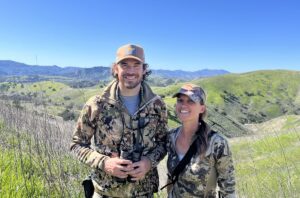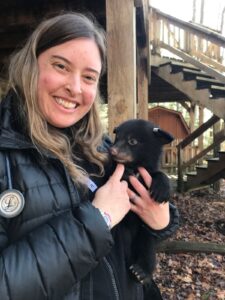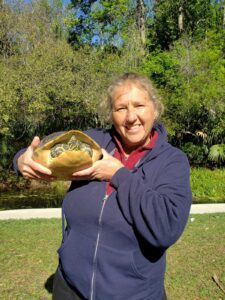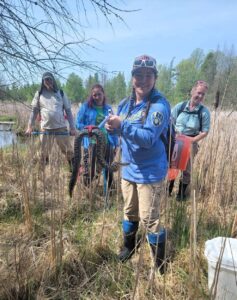Zoo staff participate in wildlife conservation and research projects locally, regionally, and internationally. We collaborate with other conservation organizations and research institutions for maximum effectiveness.
If you have an inquiry regarding a possible project at the Zoo that involves scientific research and/or biological samples, please contact the Zoo’s Conservation, Research & Sustainability Coordinator via email. Use the AZA Standardized Research Application form to submit your proposal; it can be downloaded here.
In August and October 2022, MCZ Lead Veterinary Technician, Zach Mills, assisted in the capture and collaring of mule deer in the Santa Monica National Recreation Area. The project began as a doctoral investigation unraveling predator-prey interactions between mule deer and mountain lions relative to wildfire, human activity, and human development in the greater Los Angeles area. It has evolved into a long-term research collaboration between the National Park Service, Santa Monica Mountains Foundation, and several research institutions investigating wildlife space use and connectivity in heavily urbanized ecosystems.
Each individual mule deer had blood drawn, tissues sampled, and morphometric data collected. As of November 2022, a total of 28 mule deer have been instrumented for the project with either GPS collars or ear tags for tracking.

For the past five years, Senior Staff Veterinarian, Dr. Christy Rettenmund, has assisted with annual black bear sow surveys with the Maryland Department of Natural Resources. This involves anesthetizing previously collared bear sows in March, when bears are still in their dens. Health assessments include morphometric measurements, physical exams, and blood and feces sampling. These sows typically have cubs, which are also evaluated at the same time. Exams and data collected from the cubs are used to assess health in the black bear population and monitor sow movement.
Many of the collared bears were previously nuisance bears, so tracking their whereabouts is important, and tagging their cubs allows the DNR to determine whether the cubs are becoming nuisance bears. In 2022, the team was able to check two dens and process seven cubs. These sows having three and four cubs respectively shows that the Maryland black bear population is healthy and thriving.

Zookeeper Collette Konkel has participated in five field seasons of a long-term population monitoring project of freshwater turtles in some of the Florida springs. The project involves the North America Freshwater Turtle Research Group (NAFTRG) of the Turtle Survival Alliance. The team studies 11 species and subspecies of turtles in 10 freshwater springs in several of Florida’s state parks.
Each turtle is hand-captured, measured, weighed, PIT-tagged, hand-marked, and released at the point of capture. At one of the remote sampling sites this year, 1,270 turtles were processed over a 2-day period. The NAFTRG captured and released more than 8,000 turtles in Florida in 2022.

Dawn Fleuchaus, Area Supervisor of the Zoo’s North America section, has worked with the Jamaican Iguana Recovery Group for more than 20 years. In September 2022, she assisted specifically with health screenings during hatching season of this critically endangered species.
Approximately 273 hatchling Jamaican iguanas were collected at communal nest sites. Each hatchling was weighed, measured, sexed, and marked for future identification; had tissue samples taken; and then either returned to its nest site or was transported to the Hope Zoo in Kingston for its “headstart” program.
Non-native and feral predators, including cats, dogs, and mongoose, are a serious threat to these young reptiles. Headstarting is a vital reintroduction tactic that involves raising vulnerable juvenile Jamaican iguanas to maturity while in human care, before releasing them back into their natural habitat as adults that are now able to fend for themselves — about 4-5 years later. To date, more than 550 Jamaican iguanas have been returned to the wild of dry limestone forests known as Hellshire Hills.

A threatened species that’s federally protected, eastern massasauga rattlesnakes (EMRs) have been studied as a population for more than a decade at Big Rock Valley in Cassopolis, Michigan. In May 2022, Curator Shawn Miller, Area Supervisor of the Zoo’s Aquatic & Reptile Center Melissa Spreda, and Aquatic & Reptile Zookeeper Amy De Leon participated in field work, looking for EMRs on the property.
When found, first-time captures were tagged for future identification and recaptures were logged, snakes were weighed, and their length was measured before being returned to the same spot they were found. The larger team found 46 EMRs, including 24 first-time captures that were PIT tagged for electronic monitoring and then released. The 22 EMRs that had been captured in previous years’ fieldwork were recaptured. Notable captures included a female massasauga who was captured four times in three days, and a neonate weighing less than 20 grams.
The field study was conducted through the team’s involvement with the EMR SSP® (Species Survival Plan), committed to promoting eastern massasauga rattlesnakes’ conservation in their natural habitat.

© 2025 Milwaukee County Zoo. All Rights Reserved | Privacy Policy